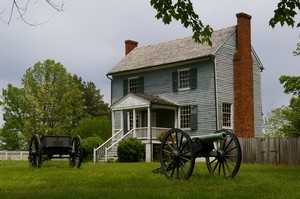 Virginia is a state full of the history of this young country and we take time to visit one of its most historic locations; the
site of Robert E. Lee's surrender to Ulysses S. Grant, signalling the beginning of the end of the Civil War. It is a place I
have read about many times bringing it alive in my imagination and therefore leading to some disappointment that the main
players and their respective armies are not still there. The name Appomattox Court House
leads to the confused belief that the surrender took place in the courthouse. However there are a number of similarly named places
in this region signifying the location of the county court house: Amelia Court House, Charlotte Court House etc.
Virginia is a state full of the history of this young country and we take time to visit one of its most historic locations; the
site of Robert E. Lee's surrender to Ulysses S. Grant, signalling the beginning of the end of the Civil War. It is a place I
have read about many times bringing it alive in my imagination and therefore leading to some disappointment that the main
players and their respective armies are not still there. The name Appomattox Court House
leads to the confused belief that the surrender took place in the courthouse. However there are a number of similarly named places
in this region signifying the location of the county court house: Amelia Court House, Charlotte Court House etc.
Lee and Grant actually met in one of the homes in the small dispersed village and it was here that the surrender was negotiated and signed. Much is made by the National Park Service of the generous conditions of surrender and the respectful and polite way in which matters were conducted. The tone is of focusing on the end of the war and the coming back together of the union rather than the grim reality of the triggers of the split and the four years of fighting. Given it is a place of reconciliation that is probably a fair approach but there's something a little uncomfortable about the self congratulatory note of the exhibits and Sterling suggests that maybe it's designed to ensure that anyone visiting, be it from north or south, can feel comfortable here and concentrate on something positive.
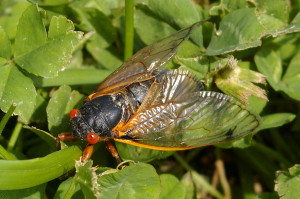 It is at Appomattox that we first see the 17-year Brood II cicadas. They
are silent but the ground and fences are covered in nymphs, empty brown exoskeletons and emerged insects. They are not quite as
large as I was expecting but their red eyes and black bodies are impressive and their orange edged wings have a beautiful
translucent appearance that more than make up for size. The next time we encounter them at
Monticello, the home of Thomas Jefferson, they are in full song high in the trees.
The sound is amazing, the very air vibrating in a mid-frequency hum, the occasional bug careening to the ground as they
obviously misjudge their flight pattern in search of a mate.
It is at Appomattox that we first see the 17-year Brood II cicadas. They
are silent but the ground and fences are covered in nymphs, empty brown exoskeletons and emerged insects. They are not quite as
large as I was expecting but their red eyes and black bodies are impressive and their orange edged wings have a beautiful
translucent appearance that more than make up for size. The next time we encounter them at
Monticello, the home of Thomas Jefferson, they are in full song high in the trees.
The sound is amazing, the very air vibrating in a mid-frequency hum, the occasional bug careening to the ground as they
obviously misjudge their flight pattern in search of a mate.
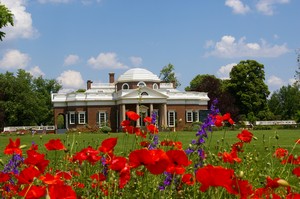 The house at Monticello is forever imprinted in the minds of Americans by virtue of being embossed on the back of the nickel.
Architected by Jefferson himself, he lived on the plantation with his extended family. We all have inconsistencies in our lives
but most of us escape without having them posthumously scrutinised. While Jefferson's ten rules for good living include "Never
spend your money before you have it." he died with debts, in todays terms, of two and a half million. His professed dislike of
slavery did not stop him owning six hundred people during his life. He designed the house so that food could be delivered from
the kitchen to the dining room by way of a revolving, shelved door ensuring that guests did not need to see more of the slaves
than was strictly necessary perhaps suggesting that he recognised the incongruity between his professed beliefs and his day to
day life. His bottom line was that he couldn't make the plantation profitable without slaves and thus justified continuing the
practice.
The house at Monticello is forever imprinted in the minds of Americans by virtue of being embossed on the back of the nickel.
Architected by Jefferson himself, he lived on the plantation with his extended family. We all have inconsistencies in our lives
but most of us escape without having them posthumously scrutinised. While Jefferson's ten rules for good living include "Never
spend your money before you have it." he died with debts, in todays terms, of two and a half million. His professed dislike of
slavery did not stop him owning six hundred people during his life. He designed the house so that food could be delivered from
the kitchen to the dining room by way of a revolving, shelved door ensuring that guests did not need to see more of the slaves
than was strictly necessary perhaps suggesting that he recognised the incongruity between his professed beliefs and his day to
day life. His bottom line was that he couldn't make the plantation profitable without slaves and thus justified continuing the
practice.
None of this detracts from his importance in birthing the modern day United State, his contributions in politics, government and through his eight year presidency, the Lewis and Clark expedition, and the Louisiana purchase; it just gives a slightly more rounded picture of the man.
Leaving Monticello, we drive up into Shenandoah National Park on the Skyline Drive where the cloud is low, reducing visibility to a matter of feet. Any thoughts of a short hike on our way to the campground are abandoned and we press on through the pea souper finally emerging into a clearing in both forest and fog at the Big Meadows area. We have come to hike the trails, enjoy the spring and get some work done.
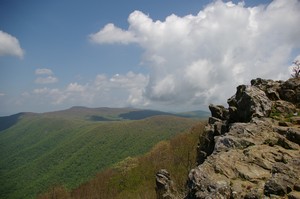 The hike up Hawksbill Mountain, the highest point in the park at 4050 feet, is short but steep and our chosen walk for the day
takes us up to the summit twice. The views over the Shenandoah valley beneath are wonderful and there's nothing quite like a well
squashed butty to rejuvenate body and spirit. Spring has just arrived here lagging behind the change at lower elevations, the
trees only now bursting out of their winter confinement, the night time temperatures still dipping towards freezing.
The hike up Hawksbill Mountain, the highest point in the park at 4050 feet, is short but steep and our chosen walk for the day
takes us up to the summit twice. The views over the Shenandoah valley beneath are wonderful and there's nothing quite like a well
squashed butty to rejuvenate body and spirit. Spring has just arrived here lagging behind the change at lower elevations, the
trees only now bursting out of their winter confinement, the night time temperatures still dipping towards freezing.
Shenandoah has a slightly murky history but not one the park service tries to hide. It found it's origins in the urge to have a park in the east to match the great western parks. In putting together the proposals for the park's creation it's authors lied about the nature and extent of human development in the area and presented it as pristine forest. The reality was far from the truth, the region being dotted with numerous small tracts of land farmed and worked by subsistence farming families. Obviously the creation of the park would mean the "relocation" of these hundreds of families and to aid this process the originators of the whole plan presented them as backward, ignorant, ill-educated people who could only benefit from being relocated into "civilisation". The signs of this past are still to be seen in clearings, homestead sites and second generation forest growing where the land was once under tobacco, sorghum, corn and the like.
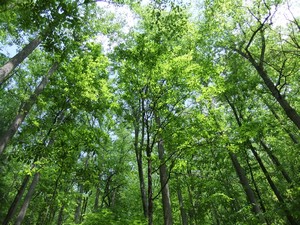 The woodland is a predominantly deciduous forest with tall canopy trees allowing varying degrees of light to feed the layers
below resulting in areas of rich undergrowth and second tier trees in places, patches of ferns elsewhere and much barer spots
where the upper foliage and aspect join to create darker areas covered in last autumn's leaves, alive with giant millipedes.
The woodland is a predominantly deciduous forest with tall canopy trees allowing varying degrees of light to feed the layers
below resulting in areas of rich undergrowth and second tier trees in places, patches of ferns elsewhere and much barer spots
where the upper foliage and aspect join to create darker areas covered in last autumn's leaves, alive with giant millipedes.
We move on to Loft Mountain campground for a few days and enjoy various other hikes rich with wild flowers and small forest mammals. Our campsite has a personal "balcony" on a rock outcrop looking to the west across the wooded hills and the valley in the distance. The tree clad hills look impenetrable, no sign of their network of trails obvious from a distance, the rounded shapes of the trees giving the appearance of softness like moss on a massive scale.
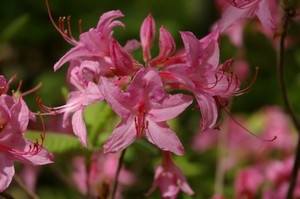 Hiking through the woods brings our focus back to more immediate surroundings; the bark on particular trees, the deep purple
of Virginia
Spiderwort flowers, the intense green of new spring growth, the rustle of towhees in the undergrowth,
the smell of azalea on the air, the feel of sun and the trace of broken spider web on the skin.
Hiking through the woods brings our focus back to more immediate surroundings; the bark on particular trees, the deep purple
of Virginia
Spiderwort flowers, the intense green of new spring growth, the rustle of towhees in the undergrowth,
the smell of azalea on the air, the feel of sun and the trace of broken spider web on the skin.
The Skyline Drive transitions into the Blue Ridge Parkway with hardly a hiccup but we're taking a slight detour to visit the Devil's Backbone Brewery. We have granted them the accolade of Best Brew Pub Ever and not just because of their incredible hospitality and generosity. Having looked for somewhere close by to stay we had emailed to ask their input on possibilities. They kindly offered to let us stay in the grounds of the brew pub thus negating any concerns about driving. At the end of the evening they gave us a growler filled with their Congo pale ale, a six pack along with various other more durable momentos. These factors alone may have made them contenders for the award but it was the other factors which confirmed our decision. The brew pub is beautiful in both design and appearance, constructed with recycled materials from old buildings in the locality. The outdoor seating areas have lovely views of the wooded mountains and are surrounded by gardens - including pond with singing frogs. Our meals were tasty and well prepared and the staff friendly. This is all before I even get to the beer. Have I mentioned the beer? Their beer styles are wide and varied and every one that we sampled was a delight from their Gold Leaf lager to the baltic porter; the beer on it's own may well have been sufficient to get them our award and in fact they have won gold medals at both The Great American Beer Festival and The World Beer Cup Awards. If you find yourself within a hundred miles you must visit! The icing on the cake for me were the fireflies that appeared all around us later that evening. Flashing on and off leaving light traces as they signaled for a mate. What an utterly delightful end to a day.
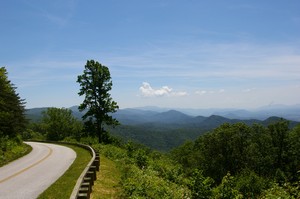 We travelled part of the North Carolina section of the
Blue Ridge Parkway
back in 2004 and now we're getting to see some of the northern section in Virginia. The parkway is an unusual National Park
venture; primarily a road that snakes along the crests of the southern Appalachians linking Great Smoky Mountains in the south
and Shenandoah in the north. It consists of a ribbon containing the road over its four hundred and sixty nine mile journey
intermittently beaded with campgrounds, visitor centres, exhibitions and trail heads. Having said that we have had some good
hikes and had the rare pleasure of seeing a newborn fawn still wobbling on its legs being licked and cleaned by the doe. Our
other treat was a Luna Moth spied on a campground building in all its luminescent green finery prompting us to continually
search tree trunks for another sighting before we leave.
We travelled part of the North Carolina section of the
Blue Ridge Parkway
back in 2004 and now we're getting to see some of the northern section in Virginia. The parkway is an unusual National Park
venture; primarily a road that snakes along the crests of the southern Appalachians linking Great Smoky Mountains in the south
and Shenandoah in the north. It consists of a ribbon containing the road over its four hundred and sixty nine mile journey
intermittently beaded with campgrounds, visitor centres, exhibitions and trail heads. Having said that we have had some good
hikes and had the rare pleasure of seeing a newborn fawn still wobbling on its legs being licked and cleaned by the doe. Our
other treat was a Luna Moth spied on a campground building in all its luminescent green finery prompting us to continually
search tree trunks for another sighting before we leave.

The Parkway is clearly strapped for money. Visitor centres and campgrounds have been closed, other campgrounds are in need of maintenance and are underused as a result, exhibit panels removed and lesser used trails remain unmaintained leading to unexpected obstacles. For all this, the rangers here are friendly and helpful and given their propensity to talk the hind leg off a donkey may not see that many visitors.
We are stuck in the camper today, rain purcussing the roof, the rumble of thunder a constant bass note. It's a day for a warm snack and I'm eyeing the ripe bananas thinking of baking. It's really an afternoon for hot chocolate in front of a roaring fire but I've just had a stern reminder from Sterling not to light one in the camper.
Update - July 21 2013
There are two further visits that deserve a brief mention before we are finally done with the Virginia mainland.
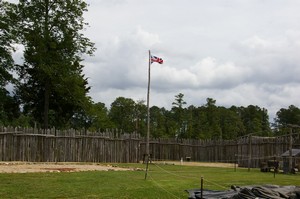 The first of these was a visit to Historic Jamestowne, the site of the first
successful English settlement in the colony of Virginia in 1607. The Union Flag of 1606 flutters in the breeze looking oddly
incomplete without the red saltire of Ireland. Very little remains of the original fort at the National Park site but
archeologists are still busy unearthing its story. We arrive as a blue glass bead used for trading with the Native Americans
is lifted from the sieve and held in a human hand for the first time in many hundreds of years.
The first of these was a visit to Historic Jamestowne, the site of the first
successful English settlement in the colony of Virginia in 1607. The Union Flag of 1606 flutters in the breeze looking oddly
incomplete without the red saltire of Ireland. Very little remains of the original fort at the National Park site but
archeologists are still busy unearthing its story. We arrive as a blue glass bead used for trading with the Native Americans
is lifted from the sieve and held in a human hand for the first time in many hundreds of years.
A recent find that is far more interesting albeit somewhat gruesome was the discovery of a girl's skull with clear signs of butchery giving credence to the belief that the early settlers resorted to cannibalism to survive the winter of 1609-10 when lack of food led to the starvation of the majority of the remaining colonists. Contemporaneously, relations with the indigenous tribes continued to be strained; trading for food was no longer an option and Englishmen found outside the fort, probably hunting, were killed. It is estimated that by 1610 disease and starvation had accounted for the deaths of between 80 and 90% of the settlers. As the current population of the States attests, this setback did not stop the immigrants for long.
The second visit was to the birthplace of Booker T (Taliaferro) Washington, born into slavery but freed at the age of seven through the Emancipation Proclamation in 1863 along with approximately three and a half million other African Americans who had been enslaved.
In spite of his complete lack of formal education during his earlier years he taught himself the basics of literacy and at the age of sixteen walked 500 miles to Hampton Normal Agricultural Institute where newly freed slaves were given a practical education. He went on to become a teacher and later the leader of the Tuskegee Normal and Industrial Institute.
One of the things we took away from the visit was a richer understanding of the period of Reconstruction, an especially dangerous period for the previously enslaved who were largely viewed as a threat by white Americans. This climate may well explain the fact that Booker T. trod a careful path, reassuring the white majority that nothing taught at Tuskegee would threaten their position and asserting that only vocational training would be provided. This line and his well publicised views on race put him at odds with other high profile African Americans who were actively demanding equality and the full rights of American citizenship. He was consulted by two successive Presidents advising them on racial matters and there is little doubt that his role arose from his non-confrontational acceptance of the status quo. It is not easy to see Booker T Washington simply as a hero and spokesman of the African Americans of his time nor as a traitor to the cause of equality. His accomplishments were significant, he was an educator, orator, author and government advisor and while on the one hand he apparently accepted the subservient position of African Americans, on the other he secretly financed several court cases challenging segregation.